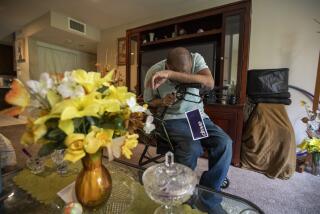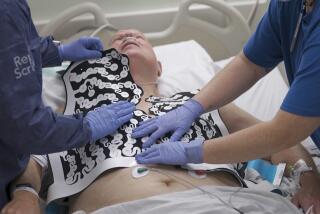Treatment Said to Cut Need for New Heart : Health: UCLA researcher says regimen of lowered blood pressure and exercise can make transplants unnecessary for about one-third of those on waiting lists.
- Share via
The need for a heart transplant among people with severe heart disease can be delayed or eliminated by a new treatment regimen that emphasizes lowered blood pressure and exercise, a UCLA researcher said Sunday.
This treatment alternative is particularly valuable because many potential transplant recipients die while they wait for a donor heart, said Dr. Lynne Warner Stevenson, a cardiologist and medical director of the UCLA Cardiac Transplantation Program. The treatment also greatly reduces the cost of heart disease care.
If the new technique were adopted at all transplant centers, Stevenson told an American Medical Assn. symposium in Marina del Rey, “we could reduce the number of people on the waiting list by a third and we’d be able to transplant more of the people who need it the most.”
The fundamental question, she said, is: “Do they really all need a transplant?” Surprisingly, the answer is no, she said, for even the diseased heart can function adequately if it is given appropriate care.
Heart failure affects 2 million Americans, of whom an estimated 40,000 might benefit from a heart transplant. Although fewer than 3,000 of those are now on waiting lists, only about 2,000 donor hearts become available each year.
Each month, therefore, the number of people who receive a heart transplant is only about half the number who are waiting for one.
That has increased the average waiting time for a new heart from seven weeks in 1984 to six months at present. If the current practice of listing patients for a transplant continues, it is projected that within three years, only critically ill hospitalized patients will receive transplants because most of those would die if they waited their turn on the list.
“We’re hurtling toward a major crisis,” Stevenson said. “We can’t rush any longer to trade in used hearts. We have to keep every one.”
The new approach challenges the conventional wisdom that heart failure is an end-stage disease for which nothing can be done short of a transplant. “There was an assumption that once the heart is very big and very weak (after multiple heart attacks or a viral infection, for example), there’s no point in trying to return to a normal level of function,” Stevenson said.
“Surprisingly enough, we can get relatively normal flows and pressure in the heart even when the size is about three times normal,” she said.
The key to the new therapy developed at UCLA is lowering what is known as the “filling pressure” of the heart. Because a damaged heart pumps more weakly than a normal one, blood tends to build up at high pressures in the atriums where it enters the heart.
Physicians have long believed that this high pressure was necessary to allow the damaged heart to continue to function. But it is also the source of most symptoms of severe cardiac disease, because the high pressure stretches the heart and causes blood to leak backward through the heart’s valves that regulate the direction of blood flow.
The UCLA team’s primary contribution has been the discovery that lowering the filling pressure allows the heart to function much more efficiently even when it is severely damaged.
In the new treatment program, the patient is hospitalized and a catheter is inserted into the heart to monitor filling pressure. An intravenous form of a drug known as an angiotensin-converting enzyme (ACE) inhibitor is administered for a day, at unusually high doses, to reduce blood pressure. “Most patients feel dramatically better within 24 hours,” she said.
Over the next two or three days, the intravenous drug is tapered off and oral doses of the ACE inhibitor and other pressure-lowering drugs are increased to keep the pressure low. The patient is also given diuretics to rid the system of the five to six quarts of excess fluid normally present in the circulatory system of a heart disease patient.
The patient usually leaves the hospital after about five days, at which time he or she is encouraged to begin an exercise program primarily involving walking. When they enter the program, Stevenson said, most patients are able to walk less than a half-block without severe problems. After treatment, most are able to work their way up to one or two miles per day, she said.
Using this technique, more than 80% of patients who are hospitalized awaiting a transplant can be sent home, and 60% can assume the same level of physical activity that heart transplant recipients undertake. Many go back to work and some have even resumed strenuous activities such as tennis.
The UCLA team has treated about 560 patients with the new approach, she said. More than 50% of the patients survive at least three years.
In contrast, the five-year survival rate for transplant patients at UCLA is 72%. But a direct comparison of those two numbers is not valid, she said. As many as 30% of potential transplant recipients die during the six months or longer that they wait for a donor organ. If those deaths are factored in, the survival rates are about the same. And the patient has avoided the $50,000 to $130,000 cost of a transplant operation.






